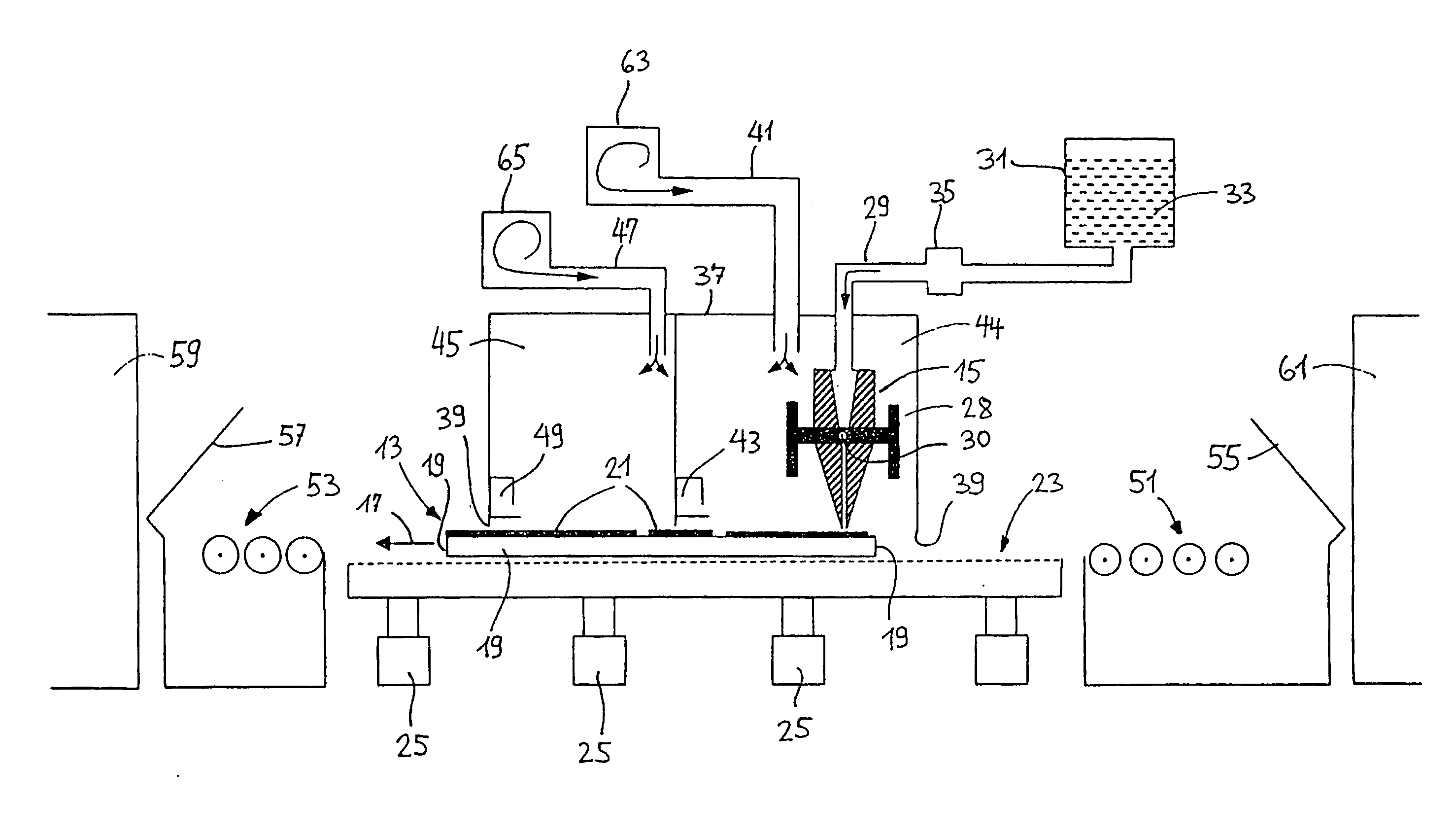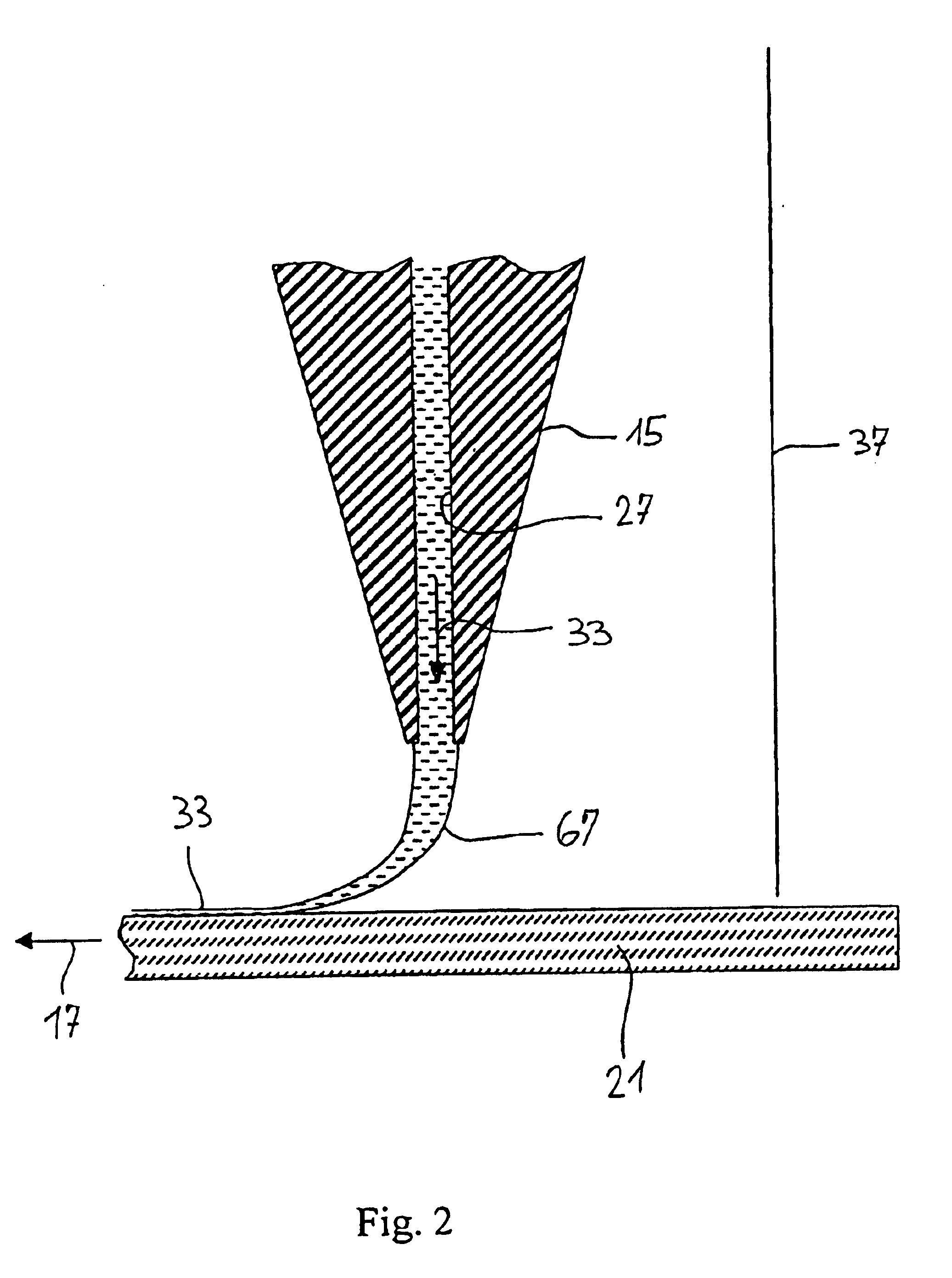Method and device for the production of an antireflective coating, antireflective coating, and antireflective-coated substrate
a technology of anti-reflective coating and production method, applied in the direction of solar heat devices, solar ray transmission and prevention of heat radiation, coatings, etc., can solve the problems of high production cost of plate glass coated with the known method, material or chemical elements, and considerable cost of vacuum coating procedures
- Summary
- Abstract
- Description
- Claims
- Application Information
AI Technical Summary
Benefits of technology
Problems solved by technology
Method used
Image
Examples
1st example
1st Example
[0075] Production of a glass plate coated on one side with an anti-reflection layer to increase the total solar transmission.
[0076] In a suitable sequence and mixture, a silane producing fourfold cross-linking, a polymethyl acrylate with a molecular weight of 996,000, sulphuric acid and water are dissolved in a solvent that is effective for all substances and has a high vapour pressure at room temperature, setting an appropriate ratio between the two macromolecular materials and forcibly mixing the solution. The solid component of the coating solution amounts to a total of 5%.
[0077] The following values of the rheological properties were measured:
[0078] Viscosity=0.60 mPas,
[0079] Normal tension=8.5 Pa
[0080] The coating speed amounts to 7.0 m / min. The thickness of the solid material amounts to about 330 nm. By means of a high-temperature shock treatment in the glass hardening process, an average increase of the total solar transmission—as compared with uncoated plate ...
2nd example
2nd Example
[0081] Production as in Example 1 but with a solids content reduced by 50%. As compared with Example 1, the solids content of the coating solution amounts to only 2.3%. The share of polymethyl acrylate was reduced to a third as compared with Example 1. The addition of sulphuric acid and water was diminished in proportion to the reduction of the silane:
[0082] The following values of the rheological properties of the coating solution were measured:
[0083] Viscosity=0.43 mPas,
[0084] Normal tension=2.8 Pa
[0085] The coating speed amounts to 7.0 m / min. The thickness of the solid material amounts to 240 nm.
[0086] By means of the high-temperature shock treatment in the glass hardening process, an average increase of the total solar transmission—as compared with uncoated plate glass—of 1.8% (measured with the Ulbricht sphere) is obtained in the spectral range from 450 to 1500 nm. The anti-reflection layer was strikingly uneven to the naked eye.
[0087] As compared with Example ...
3rd example
3rd Example
[0088] Production of glass plates with single- or multiple layer coatings on one and / or both sides.
[0089] When producing multiple coatings on glass plates, the simply coated glass plates or other substrates are either fed back by means of a technological by-pass or coated with the help of a second wide slot pourer. After leaving the coating chamber, the applied solids layer is mechanically so stable as to permit substrates coated on one side to be moved even on the coated side by means of the automated transport customary in the glass processing industry. As far as processing possibilities are concerned, prior to the glass hardening process one may therefore choose either to coat the rear side of the substrate with the same coating solution and the same coating conditions, or to coat the substrates once again on either one or two sides to obtain a double coating.
[0090] Changing the substrate speed and / or the flow quantities, it becomes possible to modify the layer thick...
PUM
| Property | Measurement | Unit |
|---|---|---|
| Fraction | aaaaa | aaaaa |
| Fraction | aaaaa | aaaaa |
| Fraction | aaaaa | aaaaa |
Abstract
Description
Claims
Application Information
 Login to View More
Login to View More - R&D
- Intellectual Property
- Life Sciences
- Materials
- Tech Scout
- Unparalleled Data Quality
- Higher Quality Content
- 60% Fewer Hallucinations
Browse by: Latest US Patents, China's latest patents, Technical Efficacy Thesaurus, Application Domain, Technology Topic, Popular Technical Reports.
© 2025 PatSnap. All rights reserved.Legal|Privacy policy|Modern Slavery Act Transparency Statement|Sitemap|About US| Contact US: help@patsnap.com



